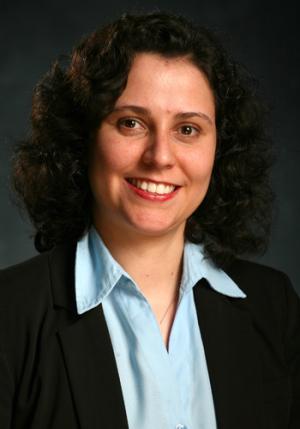A University of Houston Cullen College of Engineering assistant professor has won a $1 million grant to develop a water monitoring system that guards against disease- and corrosion-causing bacteria in water systems in real time.
The three-year grant was awarded to Debora Rodrigues, assistant professor of civil and environmental engineering, by the Qatar National Research Fund. She will pilot the technology in water systems in that country, with plans to bring it to other water systems in the future.
Rodrigues is developing the technology in collaboration with Abdelhak Bensaoula, research professor of physics and electrical and computer engineering. The system is designed to be placed in pipelines that carry water to and from water treatment plants. At its heart is a class of molecules known as aptamers, which can be designed to detect specific bacteria. The aptamers Rodrigues is using will be built to bond with disease-causing bacteria and bacteria that cause corrosion in water pipelines.
In addition to bonding with harmful bacteria, these aptamers will have another important characteristic: when they do form a bond, they will emit fluorescence. At that point, an optical sensing tool will record the fluorescence. If the threshold fluorescence is met due to a certain minimum concentration of hazardous bacteria, the system will send an alert to authorities overseeing water systems, allowing them to take action to halt a developing problem in its tracks.
Note that these alerts won’t be sent at the first sign of a harmful bacterium. A system that sends out warnings every time a bacterium is detected would produce false alarm after false alarm, in fact. For bacteria to present a real danger to people or infrastructures, there must be a specific number of these microorganisms present in the water or on the surface of a pipeline. This system will be designed to detect that specific number. In addition to the detection of microorganisms, the system will also detect environmental conditions that can encourage or inhibit the growth of hazardous bacterial populations, such as temperature and pH level.
Rodrigues’ collaborators from the University of Quebec at Montreal, led by Mounir Boukadoum, a professor of microelectronics engineering as well as an adjunct professor of electrical and computer engineering at UH, are developing algorithms that link the amount of fluorescence to the amount of bacteria with environmental factors contributing to the presence of these microorganisms in the water system. These algorithms will be integrated into the sensing and alert technology and allow the system to send out warnings as genuine problems are developing but before they become serious.
“You need to have a threshold for what is actually harmful,” Rodrigues said. “If you’re going to combine environmental monitoring with biological sensing, you need to know what conditions are most likely to produce corrosion or favor pathogens in the water. With these algorithms we can actually predict a problem. The idea is to predict so you can solve a problem before it gets bad.”
